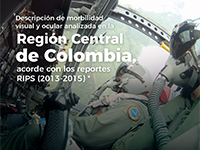A Description of Visual and Ocular Morbidity Analyzed in the Central Region of Colombia According to RIPS (2013-2015) Reports
DOI:
https://doi.org/10.18667/cienciaypoderaereo.633Keywords:
Vision Disorders, Morbidity, Prevalence, Conjunctival Diseases, Corneal Diseases, Individual Records for Health Care Delivery (RIPS)Abstract
Visual and ocular pathologies are among the main causes of vision loss worldwide. Objective: to describe visual and ocular morbidity in the central region of Colombia according to reports from the database of Individual Records for Health Care Delivery, or RIPS reports 2013-2015. Methodology: Quantitative, retrospective, descriptive cross-sectional study of the most frequent visual and ocular pathologies registered among the population of the central region of the country. For the analysis, we used the codes found in chapter VII of the International Classification of Diseases, 10th Version (ICD-10), in 18 groups, according to the classification defined by the Ibero-American Epidemiological Network in Visual and Ocular Health. (REISVO). Results: The pathologies with the highest morbidity in the central region population were disorders of: conjunctiva (15.22%); extra ocular muscles (13.37%); accommodation and refractive disorders (13.06%). Disorders of the cornea showed the lowest rates (0.7% and 1.03%). Conclusions: Conjunctival disorders had the highest rate among ocular conditions in the central region, in population ages 15-44. Female patients exhibited the highest rate of visual affections. The contributory health care system had the highest number of visual health appointments.
Downloads
References
Aragonés Cruz, B., & Alemañy Martorell, J. (2009). Relación de la radiación ultravioleta y el pterigión primario. Revista Cubana de Oftalmología, Vol. 22, p. 0. scielocu.
Asamblea Mundial de la Salud, 66. (2013). Proyecto de plan de acción para la prevención de la ceguera y la discapacidad visual evitables 2014-2019: Salud ocular universal: un plan de acción mundial para 2014-2019: Informe de la Secretaría. Retrieved from: https://apps.who.int/iris/handle/10665/150916
Castillo Estepa, A. P., & Iguti, A. M. (2013). Síndrome de la visión del computador: diagnósticos asociados y sus causas. Ciencia & Tecnología Para La Salud Visual y Ocular, 11(2), 97. https://doi.org/10.19052/sv.2504
Colombia, C. de C. Ley 1122 De 2007 (09 de enero de 2007). Legis Editores § (2007).
DANE. (n.d.). Reloj de población. Retrieved from: http://www.dane.gov.co/reloj/reloj_animado.php%3E
DANE. (2015). Proyecciones de población. Retrieved from : https://www.dane.gov.co/index.php/estadisticas-por-tema/demografia-y-poblacion/proyecciones-de-poblacion
INCI. (2015). Informe Estadístico del Instituto Nacional Para Ciegos. Retrieved from: http://www.inci.gov.co/observatorio-social/informes-estadisticos/otrosestudios-e-investigaciones
Landín Sorí, M., & Romero Sánchez, R. E. (2006). La ceguera y baja visión en el mundo: ¿un problema médico o social?. Humanidades Médicas, Vol. 6, p. 0. scielocu.
Mayorga Corredor, M. T., & Calixto Rubio, M. D. P. (2015). Caracterización de la morbilidad visual y ocular de la población atendida en la región oriental, según los reportes de los RIPS, 2009 y 2010. Ciencia & Tecnología para la Salud Visual y Ocular, 13(1), 77. https://doi.org/10.19052/sv.2891
Medrano Muñoz, S. M., & Duarte, A. (2015). Caracterización de la morbilidad visual y ocular de la población atendida en la región de la Orinoquía y la Amazonía, según los reportes de los RIPS, 2009 y 2010. Ciencia & Tecnología para la Salud Visual y Ocular, 13(1), 113. https://doi.org/10.19052/sv.3376
Ministerio de Salud Pública. Resolución 3374 De 2000. Diario Oficial No 44.276, del 30 de diciembre de 2000 § (2000).
Ministerio de Salud y Protección Social. (2015). Sistema Integral de Información SISPRO. Retrieved from : https://www.minsalud.gov.co/salud/Paginas/SistemaIntegraldeInformaciónSISPRO.aspx
Ministerio de Sanidad, G. de E. (2010). Hacia la CIE 10 (pp. 1-47). pp. 1-47. Retrieved from: https://www.mscbs.gob.es/estadEstudios/ estadisticas/normalizacion/CIE10/2010_ HaciaCIE1O.pdf
Organización Panamericana de la Salud. (2013). Actualizaciones de la CIE-10. Retrieved from: https://www.paho.org/hq/index.php?option=com_content&view=article&id=9178:2013-actualizaciones-cie-10&Itemid=40350&lang=es
Sanclemente Mesa, G., & Hernández Garzón, G. E. (2010). Altos índices de radiación ultravioleta en Medellín y en una localidad del oriente antioqueño (COLOMBIA). Latreia, Vol. 23, pp. 119-126. scieloco.
Song, P., Chang, X., Wang, M., & An, L. (2017). Variations of pterygium prevalence by age, gender and geographic characteristics in China: A systematic review and meta-analysis. PLOS ONE, 12(3), e0174587. Retrieved from: https://doi.org/10.1371/journal.pone.0174587
Walsh, K. (2009). UV radiation and the Eye. Optician, 26-33.

Downloads
Published
Issue
Section
License
Assignment of Copyrights
Authors assign Ciencia y Poder Aéreo journal the exclusive rights (reproduction, distribution, public communication, and transformation) to exploit and commercialize their work, in whole or in part, in all the formats and modalities of present or future exploitation, in all languages, throughout the life of the work and throughout the world.
All contents published in Ciencia y Poder Aéreo journal are licensed under a Creative Commons Attribution 4.0 International License, whose complete information is available at http://creativecommons.org/licenses/by/4.0/
Under the terms of this license, users are free to download, print, extract, archive, distribute and publicly communicate the content of articles, provided that proper credit is granted to authors and Ciencia y Poder Aéreo, scientific journal of the Graduate School of the Colombian Air Force. Except when otherwise indicated, this site and its contents are licensed under a Creative Commons Attribution 4.0 International License.
For other uses not considered under this license it is required to contact the Director or the Editor of the journal at the e-mail address cienciaypoderaereo1@gmail.com.
The Graduate School of the Colombian Air Force and this publication are not responsible for the concepts expressed in the articles, including the metadata or the affiliation stated by authors. This is the full responsibility of the authors.





















